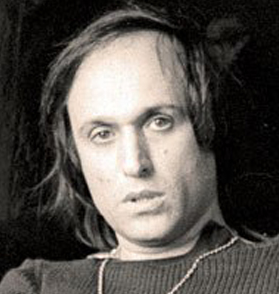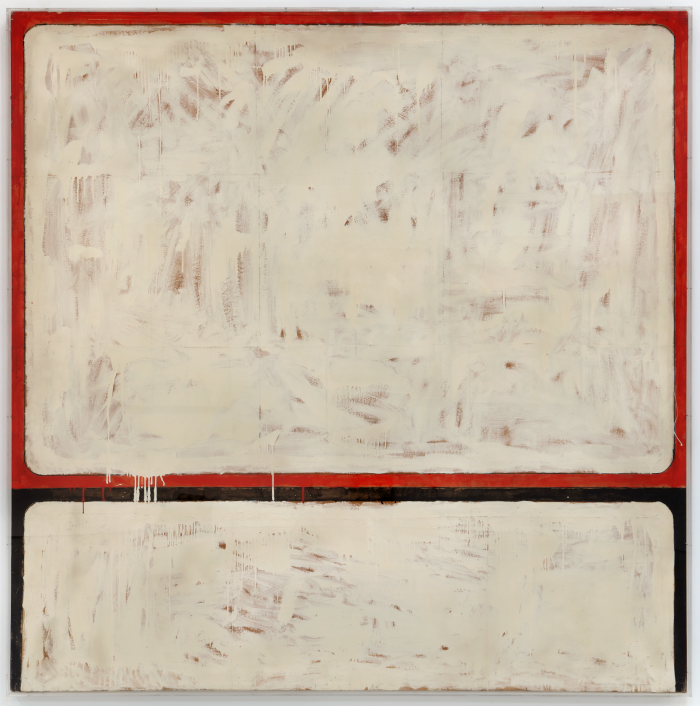Magazzino exhibit shares 1960s work by talented, but troubled, artist
One takeaway from the exhibit Germinal at Magazzino Italian Art in Philipstown is how often the artist, Mario Schifano, shifted visual and technical gears over just 10 years, from 1960 to 1970.

In Italy, the groovy 1960s collided with lingering post-World War II malaise and radical politics. Schifano visited New York City three times during the period, hobnobbing with jazz masters and hanging out with Andy Warhol, Mark Rothko and Robert Rauschenberg.
A cheeky account states that “the Rolling Stones stole his girlfriend,” Anita Pallenberg (who dated Brian Jones and had three children with Keith Richards). Later in the decade, Marianne Faithfull left Mick Jagger for Schifano.
One photo in the exhibit shows Jasper Johns preparing a libation as Schifano relaxes. The Italian’s extensive photos and films of old New York are priceless, but he also picked up a heroin habit and did not return to the city after interest in his work waned.
He continued to create, but ill-gotten fame grew with successive arrests. After spending time in a mental institution and with a band, he died in 1998 at age 63. He had exhibited all over Europe and around the world, from Tokyo to Los Angeles and South America.
This show, curated by Filippo Fossati, reimagines and streamlines the museum’s Schifano exhibition from last fall, focusing on the period when his dalliances in New York City and Italian politics informed his work.
At first, the artist’s textured monochrome paintings attracted the interest of Leo Castelli and Ileana Sonnabend, among the world’s most renowned art dealers at the time.
In his expansive studio at 791 Broadway, he created many large works, some of which conveyed motion as stencil-like people beat feet, hands extended as if marching down an urban street. One is clearly derivative of Da Vinci.
The works on display at Magazzino are smaller, including an installment of his recurring series Propaganda, which incorporated interpretations of the Coca-Cola and Esso (precursor to Exxon) logos beginning in 1962 and earned inevitable comparisons to Warhol.
His handlers wanted Schifano to keep knocking out single-color works, but he rebelled and they dropped him. The show features abstracts, what he called “anemic” landscapes, more realistic landscapes and two loud, strident images of workers holding hammers and sickles.
There is also one painting from a series of collaborations with poet and neighbor Frank O’Hara, who wrote on the canvas: “There was a lot of static – Lately deciding to be relatively evil or not I bought a wrist radio.” He added: “Images were shy and oblique and I love Federico Fellini more than grass.”
Schifano overlaid several works with plastic or plexiglass, including an untitled collage with yellow strips of jagged Perspex hanging from the top and “52 Delle Grotte Alley from the Inside in the Early Morning,” which depicts a window with an interior perspective but is covered by what resembles the material used to cover fluorescent lights.
Recurring motifs include words and slogans splashed across canvasses along with outlines of wood rulers and drafting tools, as if left on the table of a quasi-abstract artist.
Many works are embellished with random, geometrically rigid shapes disconnected from the rest of the image, like the red strips punctuating “Anemic Landscape I” and a bright-green rectangle that clashes with the unfinished red, white and brown canvas in “Propaganda Detail.”
Schifano painted flourishes around a photo of his artistic heroes, the Futurists from the early 1900s, although their faces are blanked out. Pieces from another series were influenced by his infatuation with television.
The exhibition’s title is drawn from the artist, who claimed that there are “germinal paintings, then there are the minor, smaller paintings.” His attempts to convey vibrancy and movement are crystallized by “Large Object Landscape,” which features a tree that seems to burst into a fireworks display.
In an essay culled from one of several books about the artist atop a table in the lower gallery, critic Luca Beatrice summed up Schifano’s output: “More than anything, his urge to experiment swept across the entire spectrum of his actions, from his materials and techniques to his composition and style.”
Mario Schifano: Germinal, runs through Aug. 9 in the Robert Olnick Pavilion at Magazzino Italian Art, 2700 Route 9, in Philipstown. Call 845-666-7202 or visit magazzino.art. The museum is open from 11 a.m. to 6 p.m. Thursday to Monday. Admission is $20 ($10 seniors, free for Philipstown residents).




Wonderful article! Well-written and well-researched. Bravo! It gives Current readers a clear, well-informed understanding not only of the artworks on view at Magazzino, but the history and personality of Mario Schifano, one of the greatest post-war Italian artists. April 19 is my birthday, and I considered this article my birthday gift. Thank you to Marc Ferris and to The Current.
Spanu is the co-founder of Magazzino Italian Art.
What an in-depth and articulate article about the Mario Schifano exhibit. I intend to visit the art exhibit soon. Marc Ferris is such an excellent journalist.